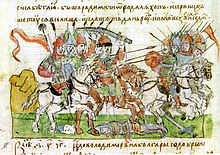Radimichs
This article may be expanded with text translated from the corresponding article in Russian. (September 2012) Click [show] for important translation instructions.
|
This article relies largely or entirely on a single source. (January 2012) |

The Radimichs (also Radimichi) (Belarusian: Радзiмiчы, Russian: Радимичи, Ukrainian: Радимичі and Polish: Radymicze) were an East Slavic tribe of the last several centuries of the 1st millennium, which inhabited upper east parts of the Dnieper down the Sozh and its tributaries. The name probably derives from the name of the forefather of the tribe - Radim.
History[]
The lands of the Radimichs were conveniently connected with the central regions of the Kievan Rus by waterway. In the 11th and 12th centuries, the Radimichs had a few known cities: Homiy (today's Homel) and Chechersk on the Sozh river, Vshchizh on the Desna River, Vorob'yin, and others. Seven-beam temporal jewelry made of bronze or silver represent a specific ethnic trait of the Radimichs of the 9th - 11th century.
There is little information on the Radimichs. According to Nestor the Chronicler, the tribe of Radimichs "sprang from the Lyakhs" or after the conquest by Vladimir the Great became part of the race of Lyakhs (Lechites, see Lendians) and used to live in areas of Sozh river. According to tradition recorded by Nestor, their name derives from the name of the forefather of the tribe, Radim, who was one of the Lyakh brothers, other being Vyatko from whom emerged Vyatichi.[1]
Historians know that in the middle of the 9th century they were paying tribute to the Khazars. In 885, the Radimichs were conquered by Prince Oleg of Novgorod and became part of Kievan Rus. In 907, the Radimichs are mentioned as a part of Oleg's army in his military campaign against Byzantine empire. In 984, the Radimichs tried to break away from the Kievan Rus, but were defeated on the Pischan River by Vladimir the Great's commander Volchiy Khvost ("Wolf's Tail").[1] Since then, there had been no mentioning of the tribe in the chronicles. They continued living on their land, gradually assimilating with neighboring tribes and peoples and forming the Belarusian nationality. Subsequently, the lands of the Radimichs became a part of the Chernihiv and Smolensk principalities.
In the Primary Chronicle, it is recorded that the Radimichs, Vyatichi, and Severians "had the same customs", all lived violent lifestyles, "burned their dead and preserved the ashes in urns set upon posts beside the highways", and they did not enter monogamous marriages but practiced polygamy, specifically polygyny, instead.[1][2]
The Radimichs were last mentioned in a chronicle in 1169.
See also[]
- List of Medieval Slavic tribes
References[]
- ^ a b c Samuel Hazzard Cross and Olgerd P. Sherbowitz-Wetzor (1953). The Russian Primary Chronicle. Laurentian Text (PDF). Cambridge, Mass., Mediaeval Academy of America. pp. 37–38, 56, 61, 64, 96.
- ^ Eve Levin (1995). Sex and Society in the World of the Orthodox Slavs, 900–1700. Cornell University Press. pp. 41–42. ISBN 9780801483042.
This article includes content derived from the Great Soviet Encyclopedia, 1969–1978, which is partially in the public domain.
- Radimichs
- East Slavic tribes
- Lechites
- 10th century in Kievan Rus'